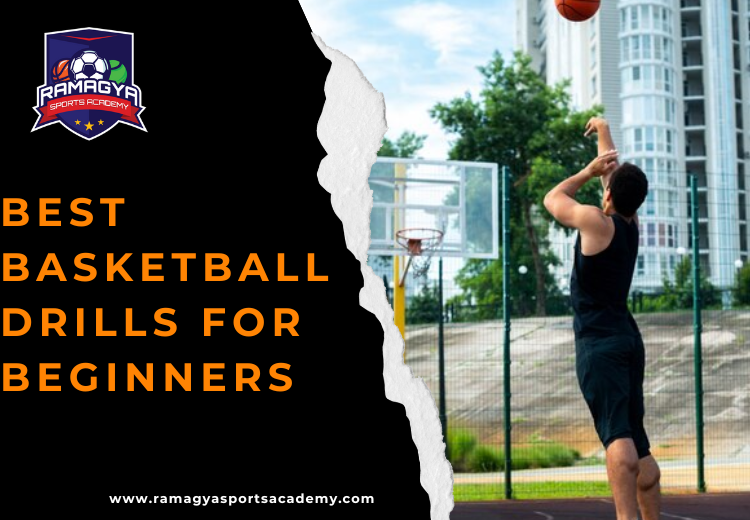
Ramagya School’s Skating Champions Triumph at SSS Gurukul Inter-School Roller Skating Championship 2024
August 15, 2024
Gold Medal Achievement for Ramagya’s Under-10 Swimming Team
August 20, 2024Best Basketball Drills for Beginners
 Basketball is a fun sport that everyone can master and enjoy, no matter if you’re just beginning or trying to enhance your skills. Beginning with the basics, and progressing slowly will make a significant improvement in your performance. Regular practice is essential to improving your skills and performance in basketball.
We’ll take a look at some of the most effective basketball drills that beginners can learn, that are designed to help you improve your skill development.
Basketball is a fun sport that everyone can master and enjoy, no matter if you’re just beginning or trying to enhance your skills. Beginning with the basics, and progressing slowly will make a significant improvement in your performance. Regular practice is essential to improving your skills and performance in basketball.
We’ll take a look at some of the most effective basketball drills that beginners can learn, that are designed to help you improve your skill development.
Importance of Basketball Drills for Beginners
Basketball skills are crucial as they assist beginners to develop fundamental skills of basketball like shooting, dribbling, passing and defending. They also help improve coordination, fitness and teamwork. When you practice these drills regularly beginner players will gain confidence and build a solid base for their basketball career. These drills will aid in the your skill development:Ball Handling Drills
- Stationary Dribbling: Sit in a place and play with both hands, focusing on control while maintaining your head high.
- Figure 8 Dribbling: Roll the ball in your legs, in a figure eight pattern, switching hands.
- Dribble Tag: Join forces with a friend and attempt to tag one another while dribbling, focusing on the speed of it and controlling.
Shooting Drills
- Form Shooting: Stand next to the basket, and focus on correct shooting form, grip the stance, follow-through, and grip.
- Spot shooting: Shoot from different spots around the key, with a focus on accuracy and consistency.
- Layup Drills: Begin under the basket, and then practice layups with both hands, and focusing on using the backboard.
Passing Drills
- Chest Passes: Sit with your partner to practice passing the ball with the chest pass technique with a focus on strength and accuracy.
- Overhead Passes: Try using the overhead pass in order to simulate passing over the defenders
- Outlet Passing: Begin by putting your feet under the basket, and then try passing the ball over to a player on the other side of the court. with a focus on distance and accuracy.
Footwork Drills
- Defensive Slides: Work on doing laterally while keeping your body in a low position and keeping your body in the middle of the basketball and the offensive player.
- Jump Stops: These are a good way to practice stopping rapidly and in a controlled manner by being able to land on both feet to keep the balance, and get ready for shooting or passing.
- Pivot Drills: Exercise pivots both feet in order to change direction and shield the ball from the defenders.
Rebounding Drills
- Box out drill: Work on getting yourself in the middle of the basket and the player to make sure you are secure with rebound.
- Tap Drills: Tap the ball against the backboard and practice gripping the rebound using both hands.
- Team Rebounding: Collaborate with your teammates to create game-like scenarios where you are competing for rebounds.
Game Situational Drills
- 3 on 3 Scrimmages: Play games with small sides to test offensive and defensive skills in a safe environment.
- Speed Breaks Drills: Train in transitioning between offense and defense in a short time with a focus on passing and finishing with a basket.
- Shots Under Pressure: Shoot with either a defender or duration limit in order to mimic the pressure of a game.
Conditioning Drills
- Suicides: The best way to prevent suicide is to run through the center of the court to reach the free-throw line, return to baseline back to half-court, then return to the baseline, focussing on endurance and speed.
- Interval Sprints: Alternate between sprinting, and jogging to increase endurance and cardiovascular fitness.
Tips for Effective Practice
The practice of these drills can aid in developing fundamental skills of basketball.- Training and Strength: Include strength-training exercises that are specific to basketball, like leg exercises to help you jump with explosive force and core exercises to build endurance and stability. A solid foundation in your physical fitness will greatly improve your performance. It is among the most essential elements of the fundamental basketball skills.
- Set Goals: Create short-term and long-term objectives for your basketball skills as well as overall performance. Set goals that are specific and measurable will help you monitor the progress you make and keep you focused through your training.
- Relaxation and Recovery: Give yourself enough time for recuperation and rest between practices and games. Resting your muscles allows them to recover, decreases the chance of injury, and makes sure that you are at your peak during competitions and practices.
- Nutrition: Keep a healthy diet that includes plenty of vegetables, fruits protein, lean proteins, as well as whole grains. A healthy diet fuels your body to perform at its best on the court and aids in the recovery of muscles after workouts that are intense.
- Game Awareness: Build a solid knowledge of basketball rules strategies, tactics, and game scenarios. A good understanding of the game’s flow as well as defensive and offensive tactics and court position improves your ability to make decisions and improves overall performance as a player. Implementing these suggestions in your basketball routine, along with practices and drills will help your progress and achievement in the sport. Continue to work hard and have fun on your basketball experience!



